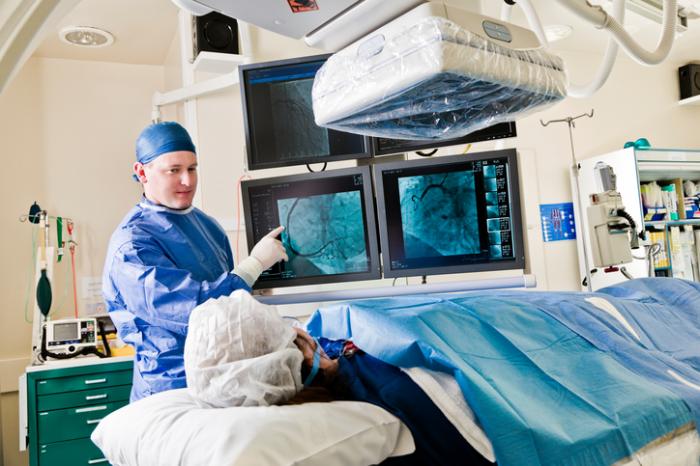Next steps after seeing a Cardiologist near me
Next steps after seeing a Cardiologist near me
Blog Article
Recognizing the Value of Cardiology in Modern Health Care Solutions
Cardiology plays an essential function in modern-day health care, especially as heart illness proceeds to be the leading reason for mortality worldwide. Developments in diagnostics and treatment have changed client treatment, allowing earlier interventions and enhanced outcomes. The change towards preventative cardiology encourages people to manage their health proactively. As modern technology remains to progress, the assimilation of innovative services may even more redefine cardiology's influence on public health, prompting a better evaluation of arising fads and their effects.
The Prevalence of Heart Problem and Its Influence On Public Wellness
Heart disease continues to be the leading reason of fatality around the world, its influence prolongs far past individual people to influence public wellness systems and economic climates. The high frequency of heart problem puts a substantial stress on medical care resources, requiring boosted funding for therapy, rehabilitation, and prevention programs. Public health and wellness efforts need to address danger aspects such as excessive weight, smoking cigarettes, and less active way of livings, which add significantly to the rising occurrence of heart conditions.Moreover, the economic burden connected with cardiovascular disease is immense, encompassing not just direct clinical costs but additionally indirect costs related to lost efficiency and early mortality. Communities encounter obstacles in taking care of these prices, commonly leading to variations in health care gain access to and end results. As the populace ages and lifestyle-related risks remain to intensify, the urgency for efficient cardiology interventions comes to be extremely important. Attending to heart disease is not just a matter of private wellness yet also an essential public health priority.
Developments in Heart Diagnostics and Imaging Techniques
Current developments in cardiac diagnostics and imaging methods have actually reinvented the area of cardiology, improving the ability to monitor and discover cardiovascular disease. Techniques such as cardiac MRI, CT angiography, and echocardiography have actually become increasingly advanced, providing in-depth photos of heart structures and features. These techniques permit the very early recognition of problems like coronary artery illness, cardiac arrest, and valvular disorders.Moreover, developments in non-invasive diagnostics, such as wearable innovation and remote monitoring devices, have empowered individuals and medical care suppliers. These devices help with real-time monitoring of heart rhythms and other necessary signs, resulting in timely treatments. Additionally, fabricated knowledge is being incorporated into imaging analysis, enhancing precision and effectiveness in medical diagnosis.
Developments in Treatment Alternatives for Heart Issues
Current improvements in cardiology have led to considerable developments in treatment choices for heart conditions. These include advanced surgical methods that boost procedural results and arising drugs that provide new opportunities for treatment. As the field evolves, these innovations play an important function in improving client treatment and outcomes.
Advanced Surgical Techniques
Technologies in medical methods have changed the landscape of cardiology, using new wish for individuals with heart conditions. Minimally intrusive treatments, such as catheter-based treatments, have greatly lowered healing times and healthcare facility stays. Strategies like robotic-assisted surgical treatment boost accuracy, permitting specialists to navigate intricate anatomical frameworks with higher accuracy. Advancements in imaging innovation help with real-time visualization during procedures, enhancing end results. Transcatheter aortic valve replacement (TAVR) exemplifies an advancement in treating aortic stenosis, allowing shutoff substitute without open-heart surgery. In addition, hybrid methods that integrate surgical and catheter-based methods give tailored services for numerous cardiac issues. These advanced medical methods not only boost individual security however also increase treatment alternatives, underscoring the vital duty of advancement in contemporary cardiology techniques.
Arising Medications and Treatments
As the landscape of cardiology remains to develop, emerging treatments and medications play a pivotal role in improving treatment alternatives for heart disease. Technologies such as novel anticoagulants and advanced lipid-lowering agents have changed the administration of cardiovascular diseases, substantially minimizing individual morbidity and mortality. In addition, the advancement of gene treatments and regenerative medication offers encouraging methods for treating problems previously deemed irreparable. Professional tests are constantly revealing the efficiency of these therapies, pushing the borders of typical therapies. Moreover, the combination of digital health technologies assists in customized medication, permitting tailored treatment strategies based on genetic and way of life factors. Jointly, these advancements underscore the vibrant nature of cardiology, enhancing individual results and redefining requirements of treatment in modern healthcare.
The Duty of Preventive Cardiology in Person Care
Preventive cardiology plays a crucial function in individual treatment by focusing on the recognition of danger elements that add to heart problem. With way of living modification techniques and very early detection techniques, doctor can successfully minimize the incidence of cardio events - Dr Garcia. This proactive method not only improves person results but also promotes lasting wellness
Risk Aspect Recognition
While cardiovascular conditions continue to be a leading cause of morbidity and mortality worldwide, reliable threat variable identification serves as a keystone of preventative cardiology. Recognizing threat aspects such as high blood pressure, household, diabetes mellitus, and hyperlipidemia background is important for very early intervention. Health care professionals use different evaluating techniques to review these elements, enabling tailored preventative measures. Additionally, comprehending an individual's way of life options, such as cigarette smoking and physical inactivity, even more educates threat evaluations. This complete assessment allows clinicians to create personalized treatment plans focused on mitigating dangers. By focusing on risk element identification, healthcare systems can improve patient end results and decrease the total problem of heart diseases, eventually adding to improved public health strategies and source allotment.
Way Of Life Adjustment Methods
A multitude of researches highlights the critical function of lifestyle adjustment techniques in minimizing heart disease risk. These strategies include nutritional adjustments, enhanced physical task, smoking cigarettes cessation, and weight administration. By taking on a heart-healthy diet plan abundant in fruits, veggies, entire grains, and lean healthy proteins, Find Out More individuals can lower cholesterol degrees and high blood pressure. Normal physical task reinforces the heart and boosts general cardio wellness. In addition, quitting smoking significantly minimizes the threat of heart problem and enhances healing rates for those with current conditions. Weight management better adds to cardio health by alleviating other threat elements such as diabetes and high blood pressure. Applying these lifestyle alters not only advertises individual health but likewise acts as a foundation of precautionary cardiology in patient treatment.
Early Discovery Strategies
Way of life modifications substantially add to lowering heart disease threats, but they are most effective when coupled with very early discovery techniques. Preventive cardiology highlights the importance of recognizing possible heart problems prior to they intensify into major conditions. Techniques such as high blood pressure surveillance, cholesterol screening, and advanced imaging innovations like echocardiograms play important duties in examining cardio health and wellness. Biomarkers and genetic screening likewise improve the accuracy of early detection, permitting for tailored precautionary methods. Regular cardiac risk analyses equip doctor to step in proactively, possibly stopping heart attacks and strokes (Cardiology care). By incorporating these very early detection techniques right into regular care, people can take advantage of timely way of living interventions and targeted therapies, ultimately improving end results and enhancing lifestyle
Integrating Modern Technology Into Cardiology Practices
As developments in technology remain to reshape various areas, the combination of ingenious tools and systems right into cardiology techniques has actually become vital for improving person care and results. Telemedicine platforms allow cardiologists to keep an eye on individuals remotely, enhancing access to care while lowering the worry on medical care centers. Wearable gadgets, such as smartwatches, enable continuous heart price surveillance, informing both clients and doctors to prospective issues in real-time. Additionally, expert system (AI) is being used to evaluate substantial amounts of heart information, assisting in very early diagnosis and personalized treatment strategies. Advanced imaging techniques, consisting of 3D echocardiography, enhance visualization of heart structures, resulting in extra specific treatments. Digital health documents (EHRs) streamline person details management, guaranteeing that cardiologists have prompt access to essential information. Together, these technical developments are transforming cardiology, promoting proactive administration and enhanced wellness end results for individuals with cardio problems.
The Relevance of Person Education And Learning and Engagement
Client education and learning and engagement play an essential role in the monitoring of cardiovascular wellness. By equipping individuals with knowledge regarding their problems, therapy alternatives, and lifestyle modifications, medical care providers empower individuals to take an active function in their treatment. This proactive strategy can lead to boosted adherence to prescribed medications, you could check here dietary adjustments, and workout programs, eventually minimizing the threat of complications.Engagement likewise cultivates a solid patient-provider partnership, motivating open interaction and trust fund. When individuals really feel notified and involved, they are most likely to voice concerns and ask concerns, which can lead to much better medical end results. Additionally, academic sources, such as workshops or electronic systems, can improve understanding and promote self-management methods. In general, focusing on patient education and learning and interaction is crucial for enhancing cardio wellness, improving lifestyle, and decreasing medical care prices related to cardio diseases.
Future Fads in Cardiology and Their Prospective Effect

Frequently Asked Inquiries
What Way Of Life Adjustments Can Minimize Heart Problem Risk?
The current question addresses lifestyle adjustments that can considerably lower heart problem danger. Cardiology Jupiter. Taking on a well balanced diet regimen, taking part in regular exercise, maintaining a healthy and balanced weight, taking care of anxiety, and avoiding cigarette can notably boost cardio health
Exactly How Can I Recognize Early Indicators of Heart Issues?
Acknowledging early signs of heart troubles involves surveillance signs and symptoms such as chest discomfort, shortness of breath, tiredness, and irregular heart beat. Prompt awareness of these signs can trigger needed clinical examination and treatment for much better outcomes.
What Are the Distinctions Between Cardiologists and Heart Surgeons?
The distinctions between cardiologists and cardiac cosmetic surgeons hinge on their duties; cardiologists mostly handle and identify heart disease through non-invasive approaches, while heart doctors do operations to fix structural heart issues. Each plays an essential, unique role.

How Commonly Should I Obtain My Heart Health And Wellness Checked?
The frequency of heart checkup differs based upon specific threat elements. Usually, adults need to undertake assessments every one to 2 years, while those with status quo might require even more regular assessments as encouraged by medical care professionals.
What Function Does Genes Play in Cardiovascular Disease Threat?
Genetics greatly affects cardiovascular disease risk, with familial patterns suggesting inherited conditions. Certain genetics can incline individuals to hypertension, cholesterol concerns, and various other cardiovascular issues, highlighting the relevance of genetic screening in reviewing heart wellness. Heart disease remains the leading reason of death around the world, its influence prolongs far beyond specific clients to influence public wellness systems and economies. Public health initiatives must address threat elements such as excessive weight, smoking cigarettes, and less active lifestyles, which add significantly to the increasing incidence of heart conditions.Moreover, the economic burden associated with heart disease is tremendous, encompassing not only straight medical prices however likewise indirect costs related to shed performance and early death. Preventative cardiology plays a vital function in individual treatment by focusing on the identification of threat elements that add to heart illness. Man-made intelligence (AI) and device learning are boosting diagnostics and person surveillance, making it possible for very early discovery of heart conditions. The distinctions in between cardiologists and heart specialists exist in their duties; cardiologists largely detect and take care of heart problems with non-invasive techniques, while cardiac surgeons perform surgical procedures to correct architectural heart concerns.
Report this page